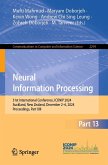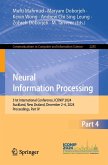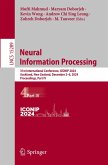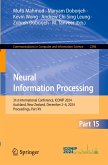Neural Information Processing
31st International Conference, ICONIP 2024, Auckland, New Zealand, December 2-6, 2024, Proceedings, Part II
Herausgegeben:Mahmud, Mufti; Doborjeh, Maryam; Wong, Kevin; Leung, Andrew Chi Sing; Doborjeh, Zohreh; Tanveer, M.
Neural Information Processing
31st International Conference, ICONIP 2024, Auckland, New Zealand, December 2-6, 2024, Proceedings, Part II
Herausgegeben:Mahmud, Mufti; Doborjeh, Maryam; Wong, Kevin; Leung, Andrew Chi Sing; Doborjeh, Zohreh; Tanveer, M.
- Broschiertes Buch
- Merkliste
- Auf die Merkliste
- Bewerten Bewerten
- Teilen
- Produkt teilen
- Produkterinnerung
- Produkterinnerung
The eleven-volume set LNCS 15286-15296 constitutes the refereed proceedings of the 31st International Conference on Neural Information Processing, ICONIP 2024, held in Auckland, New Zealand, in December 2024. The 318 regular papers presented in the proceedings set were carefully reviewed and selected from 1301 submissions. They focus on four main areas, namely: theory and algorithms; cognitive neurosciences; human-centered computing; and applications.
Andere Kunden interessierten sich auch für
![Neural Information Processing Neural Information Processing]() Neural Information Processing68,99 €
Neural Information Processing68,99 €![Neural Information Processing Neural Information Processing]() Neural Information Processing68,99 €
Neural Information Processing68,99 €![Neural Information Processing Neural Information Processing]() Neural Information Processing68,99 €
Neural Information Processing68,99 €![Neural Information Processing Neural Information Processing]() Neural Information Processing56,99 €
Neural Information Processing56,99 €![Neural Information Processing Neural Information Processing]() Neural Information Processing68,99 €
Neural Information Processing68,99 €![Neural Information Processing Neural Information Processing]() Neural Information Processing56,99 €
Neural Information Processing56,99 €![Neural Information Processing Neural Information Processing]() Neural Information Processing68,99 €
Neural Information Processing68,99 €-
-
-
The eleven-volume set LNCS 15286-15296 constitutes the refereed proceedings of the 31st International Conference on Neural Information Processing, ICONIP 2024, held in Auckland, New Zealand, in December 2024.
The 318 regular papers presented in the proceedings set were carefully reviewed and selected from 1301 submissions. They focus on four main areas, namely: theory and algorithms; cognitive neurosciences; human-centered computing; and applications.
The 318 regular papers presented in the proceedings set were carefully reviewed and selected from 1301 submissions. They focus on four main areas, namely: theory and algorithms; cognitive neurosciences; human-centered computing; and applications.
Produktdetails
- Produktdetails
- Lecture Notes in Computer Science 15287
- Verlag: Springer / Springer Nature Singapore / Springer, Berlin
- Artikelnr. des Verlages: 978-981-96-6578-5
- Seitenzahl: 484
- Erscheinungstermin: 24. Juni 2025
- Englisch
- Abmessung: 235mm x 155mm x 27mm
- Gewicht: 727g
- ISBN-13: 9789819665785
- ISBN-10: 9819665787
- Artikelnr.: 73806740
- Herstellerkennzeichnung
- Springer-Verlag GmbH
- Tiergartenstr. 17
- 69121 Heidelberg
- ProductSafety@springernature.com
- Lecture Notes in Computer Science 15287
- Verlag: Springer / Springer Nature Singapore / Springer, Berlin
- Artikelnr. des Verlages: 978-981-96-6578-5
- Seitenzahl: 484
- Erscheinungstermin: 24. Juni 2025
- Englisch
- Abmessung: 235mm x 155mm x 27mm
- Gewicht: 727g
- ISBN-13: 9789819665785
- ISBN-10: 9819665787
- Artikelnr.: 73806740
- Herstellerkennzeichnung
- Springer-Verlag GmbH
- Tiergartenstr. 17
- 69121 Heidelberg
- ProductSafety@springernature.com
Network structure and recurrent dynamics achieved by maximizing information transfer and minimizing maintenance costs of the network.- Outlier-Robust Range-Based Method for Estimating the Location and Velocity of a Moving Source Using Lagrange Programming Neural Network.- Spatial Analysis Techniques in Recognition and Localization of Mouse Neuronal Activity.- ScaleMixer: A Multi-Scale MLP-Mixer Model for Long-Term Time Series Forecasting.- Application of Pseudometric Functions in Clustering and a Novel Similarity Measure Based on Path Information Discrepancy.- USAM-Net: A U-Net based network for improved stereo correspondence and scene depth estimation using features from a pre-trained image segmentation network.- TaW-PeRCNN:Time-adaptive Weights Physics-encoded Recurrent Convolutional Neural Network for Solving Partial Differential Equations.- An Explainable Error Detection Approach for Machine Learning.- T-GET3D: A Generative Model of High-Quality 3D Textured Shapes Guided by Texts.- Conformal Adversarial Generative Ensemble.- Virtual Command Allocation: Enhancing Hexapod Robot Locomotion through Goal-Conditioned Reinforcement Learning.- Adaptive Retrieval-based Gradient Planning for Offine Multi-context Model-based Optimization.- RBHAR: Role-Based Heterogeneous Action Representation in Multi-Agent Reinforcement Learning.- Deep mixtures of variational autoencoders model for representation learning and clustering tasks.- TempoKGAT: A Novel Graph Attention Network Approach for Temporal Graph Analysis.- Direct Correlational Spike-Timing-Dependent Plasticity Learning Applied to Classification Tasks.- Wave-RVFL: A Randomized Neural Network Based on Wave Loss Function.- Dual Cross Fusion Deep-unfolding Transformer for Hyperspectral Image Reconstruction.- A weight averaging neural network for semi-supervised data stream learning.- obust Noise Tolerant Algorithm for Randomized Neural Network.- Tackling Periodic Distribution Shifts in Federated Learning with Half-cycle Knowledge Distillation.- Multi-Scale Attention Convolutional Network and Reinforcement Learning for Flexible Job Shop Scheduling.- Temporal State Prediction and Sequence Recovery for Multi-Agent Reinforcement Learning.- Data Augmentation with Variational Autoencoder for Imbalanced Dataset.- Performance Analysis of Quantum-Enhanced Kernel Classifiers Based on Feature Maps: A Case Study on EEG-BCI Data.- Certified Patch Defense via Dual Mask-Preservation Prediction.- Proximal Point Method for Online Saddle Point Problem.- Fast Preserving Local Distances and Topology in Auto-Encoders.- Neural Collapse Inspired Regularization for Deep Graph Neural Networks.
Network structure and recurrent dynamics achieved by maximizing information transfer and minimizing maintenance costs of the network.- Outlier-Robust Range-Based Method for Estimating the Location and Velocity of a Moving Source Using Lagrange Programming Neural Network.- Spatial Analysis Techniques in Recognition and Localization of Mouse Neuronal Activity.- ScaleMixer: A Multi-Scale MLP-Mixer Model for Long-Term Time Series Forecasting.- Application of Pseudometric Functions in Clustering and a Novel Similarity Measure Based on Path Information Discrepancy.- USAM-Net: A U-Net based network for improved stereo correspondence and scene depth estimation using features from a pre-trained image segmentation network.- TaW-PeRCNN:Time-adaptive Weights Physics-encoded Recurrent Convolutional Neural Network for Solving Partial Differential Equations.- An Explainable Error Detection Approach for Machine Learning.- T-GET3D: A Generative Model of High-Quality 3D Textured Shapes Guided by Texts.- Conformal Adversarial Generative Ensemble.- Virtual Command Allocation: Enhancing Hexapod Robot Locomotion through Goal-Conditioned Reinforcement Learning.- Adaptive Retrieval-based Gradient Planning for Offine Multi-context Model-based Optimization.- RBHAR: Role-Based Heterogeneous Action Representation in Multi-Agent Reinforcement Learning.- Deep mixtures of variational autoencoders model for representation learning and clustering tasks.- TempoKGAT: A Novel Graph Attention Network Approach for Temporal Graph Analysis.- Direct Correlational Spike-Timing-Dependent Plasticity Learning Applied to Classification Tasks.- Wave-RVFL: A Randomized Neural Network Based on Wave Loss Function.- Dual Cross Fusion Deep-unfolding Transformer for Hyperspectral Image Reconstruction.- A weight averaging neural network for semi-supervised data stream learning.- obust Noise Tolerant Algorithm for Randomized Neural Network.- Tackling Periodic Distribution Shifts in Federated Learning with Half-cycle Knowledge Distillation.- Multi-Scale Attention Convolutional Network and Reinforcement Learning for Flexible Job Shop Scheduling.- Temporal State Prediction and Sequence Recovery for Multi-Agent Reinforcement Learning.- Data Augmentation with Variational Autoencoder for Imbalanced Dataset.- Performance Analysis of Quantum-Enhanced Kernel Classifiers Based on Feature Maps: A Case Study on EEG-BCI Data.- Certified Patch Defense via Dual Mask-Preservation Prediction.- Proximal Point Method for Online Saddle Point Problem.- Fast Preserving Local Distances and Topology in Auto-Encoders.- Neural Collapse Inspired Regularization for Deep Graph Neural Networks.








